One of the three items I’m making for the By the Sea challenge is the lace evening dress inspired by the glowing hills and muted sea at sunset in New Zealand.

The dress had a pressing deadline: I had a wedding to attend, and needed a frock to wear. The wedding is past, the dress got made (in a massive rush, and only thanks to some help from the lovely Lynne), and worn, and I got lots of compliments on it.
But….
…I’m not quite happy with it.
Here is what it looked like at the wedding.
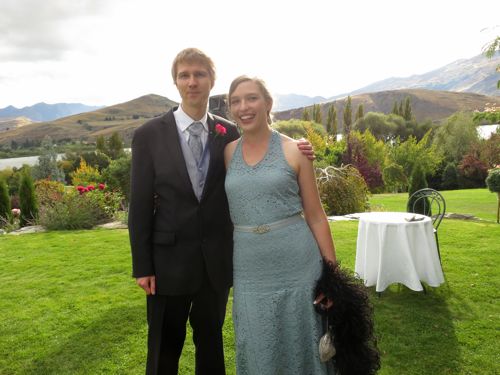
I ended up wearing it with a stunning early 20th century black feather boa (a gift from the wonderful Lynne) instead of the Capelet of Yay, because the Capelet paired with the dress was just a little too striking for the wedding, and the boa was sooooooo gorgeous and looked perfect with the dress.
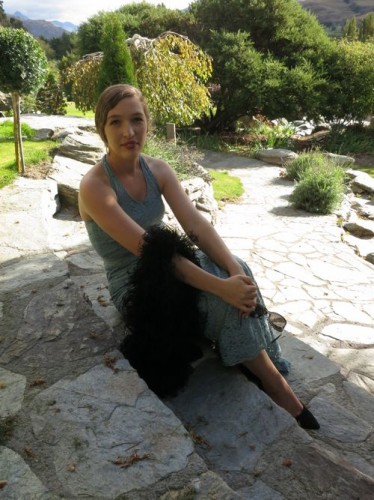
I felt great in the dress, it was really comfortable, it worked well for the wedding, and I got tons of compliments.
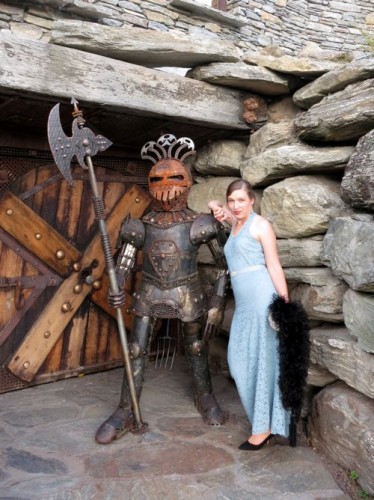
But….
…looking back at the photos I don’t love it.
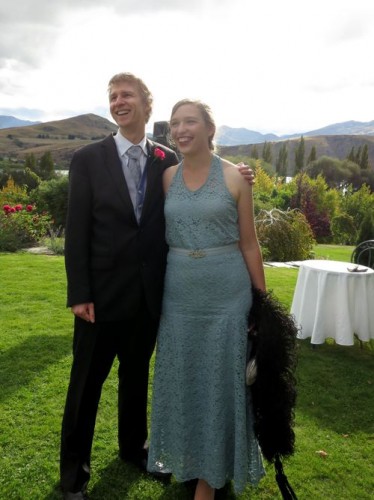
It just feels very, very straight up and down, and I look a bit thick, and the proportions are off in front (I love the back).
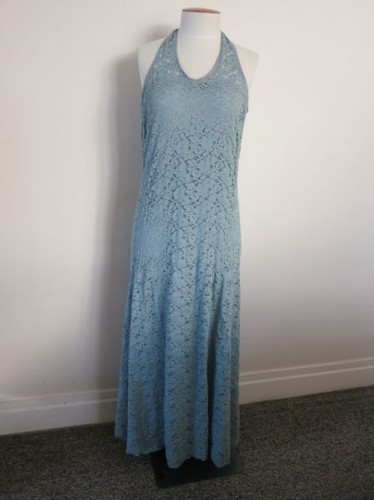
What do you think? I’m trying to figure out how to fix it. Perhaps I should go back to my inspiration image, and add a upside down V under the bust, and a bit more width and volume around the bust, to balance my figure.

I’m also torn about the way I finished the neckline. At the moment, I have it faced with the same fabric as my belt and slip, to tie that in. I like the crispness of the line – the way it contrasts with the softer lace.
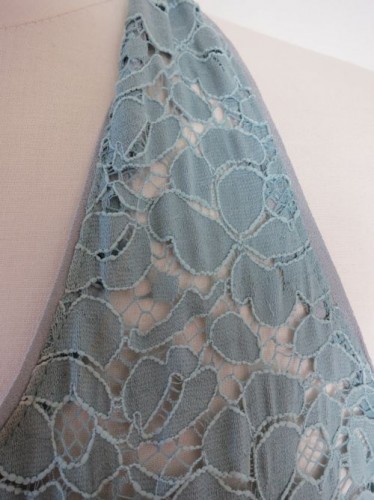
But perhaps I should have used more traditional lace finishing techniques, where you use the built-in edge scallops, and laces brilliant ability to piece, to hide and blend the edges, like I did with the hem?

And what about the skirt-to-bodice join? I originally chose lapped joins, with no lace blending, or highlighting of the seams, because that is the most common technique seen on 1930s lace dresses.
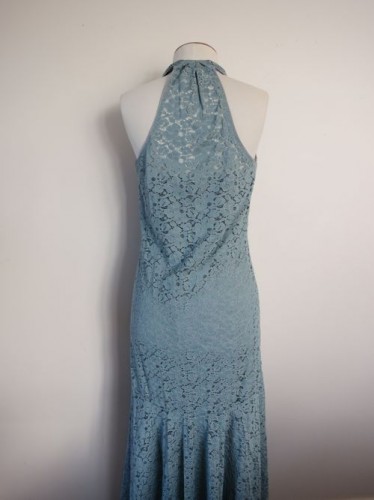
However, now that it’s done, I’m not sure I love the lapped join. It refused to be nicely symmetrical in front because the lace is slightly thicker or thinner in spots. And it’s just showy enough to be noticeable, without being a feature. I could either use lace blending (still an option at this point because of the way I cut it), or could highlight the join in the same way I made a feature of the sleeve and neck binding.
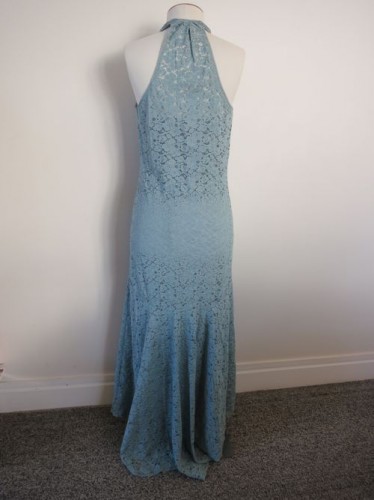
At least I am totally happy with the belt!
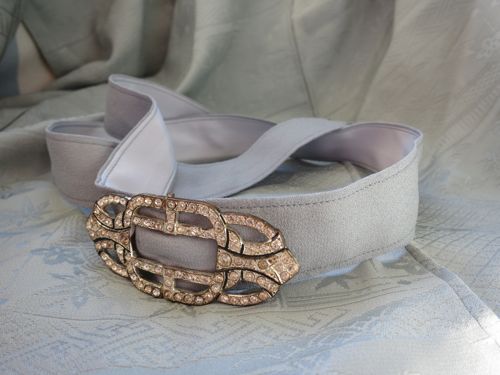
Isn’t the buckle gorgeous? It’s a vintage piece from Three Buckets Full which I rushed off to find the day before I left for the wedding. I’m so lucky they had something perfect!
Back to the dress as a whole. Gah! I’m so confused! So many options and things to think about. So what do you think? How could I make the dress work better?
While we think about it, the dress is off at the dry cleaners, having bits of lawn and lipstick and makeup removed.

The belt is beautiful, just beautiful, but like nearly all belts, it cuts the dress in half. Your inspiration design is beltless, and might well be worth another look – the V under the bust would indeed improve the fit even more. When I saw the dress without the belt, I thought it looked just lovely – very svelt and sleek.
If you look at photos of real women in the belted dresses of the time, most of them look a little blocky – unlike the sketched models on the patterns. The belt is one of the key things that fixes a dress in period. See? Contradicting myself. If you want to look sleeker, ditch the belt and make the front V. If you want to look like the perfect thirties lady, hang on to the belt!
I like the crisp neck and sleeve finish, but it would look good either way. The lace shaped edge would be like Venus rising from the sea foam, while the straight edge is Venus telling the sea foam to straighten up and fly right! (Sorry, forties!)
And the boa looks as if it is having a great time! Out of the box after all these years!
The boa had a ball! It was such a delight to wear – cool and warm and so soft. Thank you so much!
Hehe! Love your analogies!
I feel the dress actually looks worse without a belt – the belt brings the emphasis up from my stomach. But I’ll take a few more pictures and give it a try. I think the V is really the way to go.
The dress is beautiful, but you’re right that it isn’t doing your figure justice. I tend to agree with Lynne about the belt – it might be worth trying the dress without the belt and seeing what you think of it then.
I like your suggestion of adding the upside down V, and I think that would look great. I also like the neck and sleeve binding, and the lapped join. I like that you’ve used techniques that aren’t traditional lace techniques.
Thanks Stella.
I realise now how funny it is which techniques we call ‘traditional’ for lace – because really, all those techniques are 50s and later. The 20s and 30s were really the first decades when lace got used like this, and then they didn’t ‘meld’ lace like we would. It’s all about perspective!
Dear Leimomi,
It’s a gorgeous dress, and the photo of you sitting outdoors and holding your knee is so terrific that I hope it finds itself as a portrait somewhere, or at least in the family scrapbook! It’s really no wonder you had so many compliments.
Agree with the adding of the underbust vee cut and the addition of volume.
I have a 30s dress — just bought it, in fact — that uses vertical smocking at the sides, starting under the bust. In combination with a curved horizontal seam that curves under the abdomen, the dress gets enough additional ease to help minimize minimize the front width. You can see the dress on my blog at http://zipzipinkspot.blogspot.com/2013/03/a-morning-at-curtis-graces.html — it’s light blue dress towards the top of the post. Not saying that smocking would be right here — am not sure it’d work at all — but it might spark some alternative ideas should you be in the mood for experimentation.
By the way, wherever you were for the wedding looks glorious in the fall; what Greece must have been like when the gods still roamed the earth.
Very best,
Natalie
Dear Natalie,
Thanks for another vote for the V.
I’ve seen a number of ’30s dresses like the one you just bought (soooooo pretty! And in just the right colour! You lucky thing) that have side gathers or smocking. I believe Janet Arnold even has a pattern for a similar one in Patterns of Fashion. I don’t think it would work on this dress – it’s a technique that relies on the fineness of the fabric for effectiveness, and my lace is rather heavy.
Isn’t the setting gorgeous? That’s Queenstown in the South Island. It is spectacular in Autumn. NZ has been called Godzone (as in God’s Own Country) since the late 19th century, and it’s not hard to see why.
Oh, and double thank you about the photo! It is my new favourite photo of me. Mr D took it. Isn’t he clever?
Well, I have a couple of questions: What foundation garments do you wear under it? Also, how often do you work on your posture? Being small-busted, thin-but-pear-shaped, with flat tummy that I am very proud of– but very little waist-definition, I find that posture does marvels–and hitching up all hose to my belly-button so as to not create bulges or horizontal lines.
Structure-wise, I agree about the bodice. Small-busted people like us are little-served by a halter-shaped neckline. The inspiration has little poufs at the side shoulders. Maybe something like that–or butterfly sleeves would be an easy fix for it. I love my collarbones, so I actually liked Anne Hathaway’s Oscar-dress neckline. Maybe you like your collarbones, too?
I’m wearing full knee-to-underbust hug-me-tights with this, and they are evil (really evil, I need to write a post about why corsets are so much healthier and better). Whatever those lines are in the photos of me and Mr D, they aren’t knicker lines!
I have excellent posture — I’m often complimented on it. I do have a slight stomach. It’s just how my body is made and it doesn’t bug me.
Fascinating that halter necklines don’t work on you. They are often fantastic on me.
I’m confused about the “poufs at the side shoulders.” Do you mean the fullness from the neck down to the bust under the shoulders? I like my collarbones, but I have dresses that show them off, and I also love my shoulders and upper arms and back, and so have no desire to hide them with butterfly sleeves. You can see how fantastic they look in the sitting picture.
I would have to agree that the reason the inspiration dress works so well is because of the v under bust and the draping at the side arms. You version is beautiful but I think it’s a bit too tight on top. To strait with not much give which makes the lines a bit harsh. If you had the draping at the sides to soften the look and the v under bust to flatter the tummy I think the outcome would be incredible.
That is not to aw this dress isn’t lovely because it is!
Thanks! I’m really thinking the V is the way to go. Not sure if I want the neck V with the underarm draping of the inspiration, or a higher, gathered halter, like the lemongrass yellow silk halter I’m wearing in this post: https://thedreamstress.com/2013/02/dressing-deco-in-modern-clothes/
I agree. Loosen the bust and tighten up the under-bust.
If you put the inverted V seam in, then you can make the section from your waist to under-bust as smooth as the section over your hips. Then you can add fullness to the bust area which will get rid of those radiation wrinkles and be more flattering to your shape.
I think your finishes are lovely and will not impact the finished look of the dress as much as perfecting the fit will.
Thanks for sharing. 😀
This is the downside to the things we make. We know every stitch and seam. If we aren’t happy with it then it can lead to dis-satisfaction with overall garment. Sometimes I need to stand back for a while, even forget about how I made a garment and then revisit it later only to discover that it isn’t as bad as I thought.
This is a beautiful dress. (Yes I know I’m biased because I love the 1930’s). I love the shade of blue, the lace and the line of the dress. You look lovely in it. A perfect wedding dress (in a non-bridal sense). Well done.
Haha! “biased because you love the 30s”! You know, as in biased-cut gowns?
Hi Lemomi,
First, I just want to compliment you on your increadible talent. I love the designs you use for your inspiration.
For this particular dress I think it begs for a spring of color around the shoulders. I’m inclined to suggest the hugh of the soft yellow sun against the green hills in your photo of the bay. I think the gathered fabric around the bust in the drawing will diminish the bust further but it’s worth playing with the fabric to see if it can work.
It looks like there is enough play in the ribs to add the upsidedown V darts or change it out with a seperate panel if needed. The V would really give the whole dress more shape. With that, I think you will find that the belt detracts from the curves that the dress is meant to emphasize.
Good luck!
Very interesting to read the suggestions in the comments! What clever readers you have!
My first thought was to shorten the bodice so that the skirt section starts about 5 inches higher for less fit and more float through lower torso – a correspondingly higher hem and a bit more ankle showing would be nice too.
But all of the ideas above, including simply trying it without the belt, and particularly adding butterfly sleeves, are fantastic.
…shucks!Awww….shucks! The shorter skirt sounds interesting, too! (Isn’t it fun to look at all of these beautiful things she sews???)
Everyone else has had great suggestions — I agree that the shoulder areas are what seem off proportion-wise, so maybe doing something different up there. I could also see a way deeper V neckline working, with a faux chemise under layer (in like a pale blue or ivory china silk?) doing something interesting.
But, more importantly, this is all nitpicking — it’s gorgeous!
Agree the dress needs to fit better under the bust and an inverted V is probably the best solution.
Just to add that I also think the V of the neckline is sitting just a smidge too high and dropping it a tiny bit will also help to give a better proportion to the top half.
As for belt/no belt, sometimes you just have to see what you like best. I am tall and have a very small waist but sometimes it just cuts you in half an distracts from the overall flow of the garment.